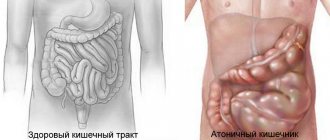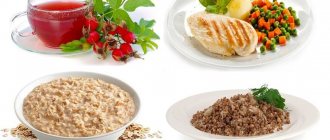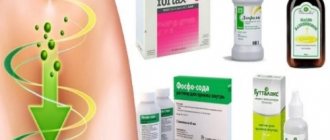05/24/201705/24/2017 Elena KirichenkoSymptoms
The human digestive system is very sensitive, various changes in diet, infectious diseases, taking antibiotics, and even stress can lead to disruption of its functions and cause diarrhea. When treating diarrhea, an important point is to follow a gentle diet aimed at restoring intestinal microflora and normalizing the synthesis of enzymes involved in the digestion of food and absorption of nutrients.
- 2 Features of the diet - table No. 4
- 3 What can and cannot be eaten for diarrhea in adults and children
3.1 Allowed and prohibited foods for diarrhea - table
- 3.2 Healthy and neutral foods for diarrhea - photo gallery
- 5.1 Rice porridge with apples
The purpose of the diet for diarrhea, depending on the causes of its occurrence
Diarrhea is a pathological condition of the body in which frequent bowel movements are observed, and the stool becomes liquid or watery. Diarrhea is often accompanied by abdominal pain, flatulence, heartburn and belching.
There are spontaneous diarrhea - caused by nervous overexertion, overexcitement, or consumption of incompatible foods. As a rule, this problem does not require drug treatment, and subject to a special diet, it goes away on its own within the first 24 hours. Since poor nutrition can aggravate the situation and lead to the development of acute diarrhea, experts recommend that adult patients refrain from eating for the first 5–6 hours.
Acute diarrhea, which occurs as a result of digestive upset due to poisoning with low-quality products, viral and bacterial infections, has more pronounced symptoms and lasts up to three weeks. In this case, you cannot do without special treatment that eliminates the root cause. Following a diet for acute diarrhea helps to shorten the recovery period and prevents the occurrence of complications, such as dehydration, inflammation of the pancreas, gastritis . The main goals of such a diet:
- replenishment of nutrients in the body, preventing exhaustion;
- removal of toxins;
- elimination of the inflammatory process;
- replenishment of water balance;
- restoration of intestinal microflora;
- reducing the load on the digestive organs.
If loose stools occur periodically over a long period of time (the pathological condition lasts more than 3 weeks), chronic diarrhea is diagnosed. The cause of this disorder may be irritable bowel syndrome, dyspepsia, pancreatitis, colitis and enterocolitis, impaired bile outflow, dysbiosis, and inflammation of the gastrointestinal tract. Diarrhea in such diseases is a secondary symptom that occurs against the background of impaired digestive function and absorption of fluid in the intestine, and slower peristalsis.
A prerequisite for recovery is limiting the diet, excluding from it foods that can irritate the mucous membrane of the stomach and intestines, activate fermentation processes and cause bloating, and are difficult to digest.
Abdominal pain with diarrhea is one of the signs of the development of a serious disease caused by infection or inflammation of the gastrointestinal tract
What are the dangers of intestinal inflammation and diarrhea?
Typically, diarrhea develops as a result of irritation or inflammation of the intestines, which leads to the secretion of fluid and salts into the intestinal lumen and loss of them in the stool. Acute inflammation, in addition to the unpleasant symptoms of pain, bloating and nausea, sometimes with vomiting, also causes dehydration and loss of nutrients such as salts and vitamins. In addition, a disruption of the microbial flora occurs, especially if it is severe diarrhea and intestinal infection, requiring antibiotics or other medications. Therefore, to suppress inflammation, in addition to treatment with drugs, it is also important to have proper nutrition, which will not irritate the intestinal wall and will help to quickly consolidate stool and provide the body with all the necessary nutrients. The composition of products that are allowed for a particular type of diarrhea is determined by the doctor; it depends on what causes the inflammation and stool disorders.
Features of the diet - table No. 4
For digestive disorders accompanied by diarrhea, it is customary to take table No. 4 as the basis of nutrition. The therapeutic diet is aimed at maintaining the body’s strength during the recovery period, restoring metabolism and protecting the digestive system from irritants.
When following a diet, the energy needs of the patient’s body are taken into account in accordance with age, gender, and physiological indicators (height, weight). However, the energy value of the daily diet should not exceed 2000 kcal. Reducing calories is achieved by excluding from the menu foods containing fast carbohydrates and refractory fats of animal origin.
In order not to overload the stomach, split meals are recommended, in which the volume of portions is reduced and the frequency of meals is increased to 6–7 times a day. The liquid necessary to restore water balance should be consumed 10–15 minutes before meals and half an hour after meals. Thus, gastric juice, containing hydrochloric acid and enzymes necessary for digesting food, is not diluted and is able to cope with its tasks.
To prevent damage to the inflamed mucosa and protect it from the effects of thermal, chemical and mechanical irritants, food is taken warm, without spices or sweeteners, in liquid or puree form. Preference is given to boiled or steamed dishes.
The duration of the diet depends on the cause of diarrhea and the duration of treatment. After recovery and normalization of stool, doctors recommend adhering to the same dietary principles for two weeks, gradually adding foods prohibited by the diet to the diet.
Diet No. 4 according to Pevzner is the basis of the diet not only for diarrhea, but also during the recovery period of patients after surgical treatment of the gastrointestinal tract
https://youtu.be/mDzbrh8vx7g
Basic rules of therapeutic nutrition
The intestine is the most important digestive organ. Conventionally, it is divided into the small and large intestine. In the initial sections, food is broken down and nutrients are partially absorbed. The large intestine serves as a reservoir for feces, water is absorbed in it, and digestion is completed. With inflammation, the intestines lose a number of their functions, and disruptions occur in the gastrointestinal tract.
With the help of a properly formulated diet, a number of therapeutic problems can be solved, so it must comply with the following principles:
- follow the correct diet - eat regularly at the same time;
- the diet should be varied and balanced;
- It is important to compose the menu personally, taking into account the characteristics of a particular case;
- Fats and carbohydrates are limited to a minimum level, proteins are left in normal quantities;
- food must be properly thermally processed - boiled, baked, steamed;
- salt is limited to 9 g per day;
- food should be liquid, semi-liquid and always well chopped;
- very hot and cold foods are excluded;
- recommended daily caloric intake – 2000 kcal;
- maintain a water-drinking regime - drink at least 1.5 liters of liquid per day.
The main task of nutrition during intestinal inflammation is maximum mechanical and chemical sparing of the affected mucosa, eliminating fermentation processes.
What you can and cannot eat for diarrhea in adults and children
The list of prohibited foods is quite extensive and includes foods that, one way or another, can provoke increased secretion of the stomach, increase intestinal motility, and cause rotting and fermentation processes.
Allowed and prohibited foods for diarrhea - table
| Product groups | Can | It is forbidden |
| Dairy and fermented milk products |
|
|
| Bakery products |
|
|
| Meat | Lean meat - chicken, rabbit, beef. Steam cutlets and meatballs are prepared, and boiled minced meat is added to porridge or mashed potatoes. | Fibrous or fatty meats, sausages and processed foods. |
| First meal |
|
|
| Fish | Low-fat fish varieties - hake, pollock, flounder. Fish dishes are prepared in the same way as meat dishes. | Fish of fatty varieties, as well as salted, dried, smoked and fried. |
| Vegetables | Boiled or baked vegetables - potatoes, carrots, pumpkin in the form of puree or pureed soups. |
|
| Fruits and berries |
|
|
| Cereals and pasta | Boiled or mashed porridge in water, made from rice, semolina, sago, buckwheat, oatmeal. Rice in the form of a viscous decoction is especially useful in the first days of acute diarrhea, as it has astringent properties. Buckwheat restores the functioning of the pancreas, and oatmeal coats the mucous membrane, relieving the symptoms of inflammation. |
|
| Dessert |
|
|
| Beverages |
|
|
To restore water balance during diarrhea, it is recommended to drink clean, non-carbonated water in quantities appropriate to age and body weight:
- children weighing up to 10 kg - 100 ml/kg + 20 ml after each loose stool;
- children from 10 to 20 kg - daily intake 1000 ml + 50 ml for each kg over 20;
- children and adults from 30 kg - 1500 ml + 20 ml for each kg over 30.
Breastfed children, in addition to mother's milk, can consume foods that were previously introduced into the diet. Preference is given to gluten-free and dairy-free porridges (without sugar), pureed potato and carrot soups. Diet table No. 4 should be followed by the mother feeding the baby.
Healthy and neutral foods for diarrhea - photo gallery
Persimmon has astringent properties
Homemade yogurt restores microflora and strengthens the immune system
Rice porridge with water is the first food given to a patient with acute diarrhea.
Jelly made from blueberries, dried fruits, cranberries or viburnum jam has a positive effect on digestion
Kefir restores intestinal function and has a mild strengthening effect
Bananas are rich in calcium and are essential for restoring nutrient balance.
Dried blueberries improve digestion, absorb and remove toxins
Do not forget about restoring the water balance; in case of diarrhea, the amount of liquid you drink should be increased by 30–40%
Foods prohibited for diarrhea: fruits, fatty, spicy foods
To eliminate diarrhea as quickly as possible, unloading and maximum sparing of digestion in the first days of inflammation are necessary. Therefore, any food that has an aggressive effect on the intestinal wall, is difficult to digest and takes a long time to digest, and leads to active bile secretion (it can increase diarrhea) is prohibited. Therefore, fresh fruits and juices from them (especially boxed and fresh), as well as vegetables with coarse fiber or raw (cabbage, radishes, cucumbers) are excluded from the diet. All store-bought dishes with semi-finished products (cutlets, dumplings or dumplings), any fried and fatty foods, legumes, fresh pastries and bread (both white and gray) and sweet foods are also cancelled. Sweet fruits, sugar and fresh bread lead to increased intestinal fermentation.
In addition, it is important to avoid fatty milk and dairy products, fatty fish and poultry, meat, as well as rich broths. At first, the ban includes pasta and cereals (millet, barley), eggs in any form, sauces - mayonnaise, ketchup, soy, as well as spices and all peppered, hot and spicy dishes, marinades and pickles.
Sample menu for the week - table
| Day of the week | 1st breakfast | 2nd breakfast | Dinner | Afternoon snack | Dinner | Late dinner |
| Monday |
| blueberry jelly |
|
|
| 1% kefir |
| Tuesday |
|
|
| jelly |
| yogurt |
| Wednesday |
| jelly |
| kefir |
|
|
| Thursday |
| yogurt |
|
|
| jelly |
| Friday |
|
|
|
|
| baked apple or quince |
| Saturday |
| yogurt |
| baked pumpkin pulp |
|
|
| Sunday |
| half a persimmon |
| jelly |
|
|
As can be seen from the table, the menu when following the diet table No. 4 is quite varied, however, in the first two days it is recommended to limit your diet, eating mainly boiled rice, potatoes, kefir, crackers and a lot of liquid. New products are introduced gradually, so boiled ground meat can be added to the puree on the third day, and eggs and fish - only on the fourth.
Irritable bowel syndrome
Irritable bowel syndrome (IBS) is characterized by impaired intestinal motility.
This violation is expressed by such phenomena as:
diarrhea; bloating; intestinal colic without infectious or immune damage in the intestines; constipation or a combination of diarrhea and constipation.
Causes of irritable bowel syndrome:
stress, most often IBS manifests itself in young people and women of different ages; unhealthy eating behavior, an abundance of fatty, high-calorie foods, insufficient dietary fiber in food; hormonal levels in women (diarrhea is observed at the beginning or end of menstruation); abuse of alcohol, coffee and carbonated drinks drinks; intestinal dysbiosis.
To get rid of IBS, it is necessary to analyze the factors that cause it and take measures to eliminate them.
What to eat for diarrhea in adults with irritable bowel syndrome:
All types of porridges cooked in water. Boiled or steamed vegetables. The exceptions are irritating intestines, cabbage, cucumbers, tomatoes. Fruits in the form of puree or baked (apples, pears). Boiled, baked or steamed meat and fish in the form of cutlets or meatballs. Fermented milk products.
Until the consequences of IBS are eliminated, the following are excluded from the diet:
fresh vegetables and fruits; nuts, mushrooms; any pastries; carbonated and alcoholic drinks, coffee.
Diet recipes
Rice porridge with apples
Ingredients for 1 serving:
- rice - 4 tbsp. l;
- water - 300 ml;
- apple - 1/2 pcs.
Preparation:
- Rinse the rice and place in a small saucepan.
- Pour water and put on low heat.
- Cook, stirring occasionally, for 25 minutes. If necessary, add boiled water.
- Peel and seed half an apple and cut into cubes.
- Add the chopped apple to the rice and cook until it becomes soft. The cooking time depends on the type of fruit.
- Remove the finished porridge from the heat and grind through a sieve.
- Serve warm without sugar.
When preparing such a dish for a child, you should bake the apples in the oven, and only then add them to the porridge
Steamed egg white omelette
Ingredients:
- egg whites - 2 pcs;
- water - 75 ml;
- a little salt.
Preparation:
- Separate the whites from the yolks.
- Add a little salt and the required amount of cold boiled water.
- Beat with a whisk until smooth, but not until foamy.
- Pour the protein mass into a ceramic or silicone heat-resistant mold and cover with a lid. Instead of a lid, you can use food foil.
- Steam for 20–25 minutes. When preparing a diet omelette on the stove, you can use a water bath by boiling water in a saucepan and placing the mold in it so that the water level is level with the egg mass in the mold. Next, you should reduce the heat and cook the omelette until done.
Children can prepare such an omelet in silicone molds in the form of funny little animals, this will lift their spirits and increase their appetite.
Chicken and rice meatballs baked in the oven
Ingredients:
- chicken fillet - 100 g;
- rice - 1 tbsp. l;
- a little salt.
Preparation:
- Wash the fillet and grind through a meat grinder several times.
- Rinse the rice and boil in water until it becomes a viscous porridge.
- When the rice has cooled, combine it with minced meat and add a little salt.
- Knock out the minced meat and roll it into balls with your hands dipped in cold water.
- Place the meatballs in a heat-resistant dish and cover with cold water to 1 cm.
- Place in a cold oven and turn it on to 180 degrees.
- Bake for 25 minutes.
The same dish can be prepared in a slow cooker
Diarrhea in older people, causes and features
Why do older people often suffer from diarrhea?
As the body ages, the gastrointestinal tract and all organs, including those associated with food intake and absorption, gradually reduce their activity. Elderly people have difficulty chewing food, partly due to loss of teeth and weak functioning of the salivary glands, partly due to decreased tone of the masticatory muscles. Food becomes harder to swallow and digest. The blood supply to the esophagus and stomach is disrupted, there are not enough enzymes for normal digestion, the intestinal microflora changes for the worse, and there are more and more endotoxins in it. The functions of the pancreas, gallbladder and liver also decrease, which negatively affects the intestines (there is a risk of stone formation) and overall metabolism. Toxic substances, including after taking medications, are not completely eliminated from the body and accumulate.
Malfunctions of the digestive organs and various diseases (Crohn's disease, ulcerative colitis) when eating in old age often lead to constipation or diarrhea, causing suffering to the elderly
Viral or bacterial infections can also cause diarrhea. Bacteria contained in contaminated water or food often cause poisoning and, as a result, diarrhea. With long-term use of antibacterial drugs, the number of bacteria insensitive to the drug increases in the intestines, which can also cause stool upset. In addition to all the listed factors, the reason that provokes a malfunction in the digestive system and the appearance of diarrhea can also be psychological factors - stress or depression.
Hot pepper
Hot chili peppers can significantly increase the severity of diarrhea. It irritates the gastric mucosa, which leads to bloating and diarrhea. Experts do not recommend consuming any type of pepper for people who have problems with the gastrointestinal tract. Studies show that taking chili peppers increases abdominal pain several times in patients with irritable bowel syndrome. When diarrhea begins, it is advisable to exclude other spices from the diet until the stomach and the body as a whole are completely restored.
When is a doctor needed?
You should consult a doctor if your child has diarrhea. As for adults, they often self-medicate and believe that diarrhea is not a pathology, but a simple intestinal disorder that can be cured at home.
Even an adult needs medical help for diarrhea if the following symptoms are observed:
- blood, mucous impurities or pus are observed in the stool;
- the condition does not stabilize within three days, but only worsens or remains at the same level;
- stool takes on a black tint - this happens when internal bleeding occurs in the gastrointestinal tract;
- sharp pain in the abdominal area indicates the development of gastrointestinal pathology, which in some cases requires surgical intervention;
- an increase in body temperature that lasts more than three days.
A doctor's help is also required if signs of dehydration appear. Elderly people definitely need to see a specialist. Elderly people who self-medicate are at risk of serious complications.











